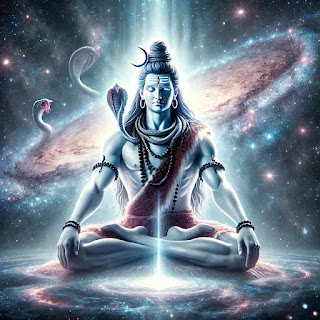Shiva in the Upanishads – Secrets of the Eternal Beyond Life and Death
Shiva in the Upanishads – Secrets of the Eternal Beyond Life and Death
Introduction
The Upanishads, the philosophical essence of the Vedas, describe Lord Shiva as an eternal, formless, and limitless reality. He is beyond birth and death, existing as the supreme consciousness that pervades the entire cosmos. Unlike human beings or celestial deities who undergo birth and rebirth, Shiva is described as Ajah (unborn) and Akshara (imperishable). The Upanishads affirm that Shiva is the ultimate truth, the formless and eternal Brahman.
1. Shiva in the Shvetashvatara Upanishad (400–200 BCE)
One of the key Upanishads that elaborates on Shiva's nature is the Shvetashvatara Upanishad. This text clearly establishes Shiva as the supreme, unborn force.
Shvetashvatara Upanishad 6.2: "He is the one God, hidden in all beings, all-pervading, the inner self of all creatures, the overseer of all actions, who dwells in all beings, the witness, the knower, and the only one beyond attributes."
This verse affirms that Shiva is omnipresent, unborn, and beyond all worldly limitations. Unlike ordinary beings, he does not take birth but exists eternally as the inner consciousness of all. The Upanishad further describes Shiva as the cosmic ruler who is both immanent (present within creation) and transcendent (beyond creation). This supports the idea that he is beyond birth and destruction.
Shvetashvatara Upanishad 4.10: "The one who has known that great eternal being, who is self-luminous and beyond all darkness, transcends death and attains immortality."
This clearly indicates that Shiva is beyond death and birth, existing as eternal consciousness.
2. Shiva as the Supreme in the Kaivalya Upanishad (200 BCE – 100 CE)
The Kaivalya Upanishad further portrays Shiva as the eternal, self-existent supreme being.
Kaivalya Upanishad 7-8: "I am beyond mind and intellect, beyond name and form. I am Shiva, the absolute truth, formless and unborn."
This passage highlights that Shiva transcends the limitations of physical existence and mental constructs. He is pure awareness, without birth, decay, or destruction.
Kaivalya Upanishad 23: "He who knows that Supreme Brahman, which is eternal, birthless, and beyond all attributes, is freed from all bondage and attains liberation."
This Upanishadic verse confirms that Shiva is not subject to the cycle of birth and rebirth but is the ultimate reality itself.
3. Mandukya Upanishad (500 BCE – 200 CE) and the Concept of Turīya
The Mandukya Upanishad explains the four states of consciousness: waking (Jagrat), dreaming (Swapna), deep sleep (Sushupti), and Turīya, the ultimate state of pure consciousness. Shiva is identified with this highest state.
Mandukya Upanishad 7: "That which is neither conscious nor unconscious, neither born nor dying, beyond duality – that is Shiva, the supreme truth."
This confirms that Shiva is beyond all states of existence and remains the eternal witness of creation. The concept of Turīya represents a state of pure awareness, free from the illusion of birth and death, which aligns with the notion of Shiva as the unborn and eternal being.
Mandukya Karika 3.37 (by Gaudapada, an early Advaita philosopher): "The Self (Shiva) is never born nor does it die; it neither comes nor goes. It is unborn, eternal, and unchanging."
This philosophical interpretation reinforces that Shiva is beyond temporal existence, existing as the eternal absolute.
4. Puranic Interpretations – Shiva as Swayambhu
The Shiva Purana and Linga Purana reinforce the Upanishadic idea that Shiva was never born but manifested himself as Swayambhu (self-created).
Shiva Purana 2.1.16: "Shiva existed before creation, self-manifested and without birth. He is the eternal light, beyond time and form."
This text indicates that Shiva’s presence is independent of creation, and he does not take birth as other beings do.
Linga Purana 1.7.5: "From the infinite void emerged a pillar of light, boundless and uncreated. That was Shiva, the eternal force of the universe."
The Jyotirlinga (pillar of light) symbolizes the unborn and infinite aspect of Shiva. This story is a metaphorical way of explaining that Shiva is not born but always exists beyond time.
Vayu Purana 1.22.4: "Before creation, there was only one existence, the formless and eternal Shiva, who alone is real."
This confirms that Shiva existed before the universe itself and was never born.
The universe is whispering its secrets—are you ready to listen?
Dare to know more? Enter the realm of cosmic truth.
At the end of this journey, you will never see reality the same way again. Are you ready to break the illusion? Deep dive into www.rudradoota.com



%20from%20the%20cosmic%20void.%20The%20scene%20is%20gr.webp)


0 Comments:
Post a Comment
Subscribe to Post Comments [Atom]
<< Home